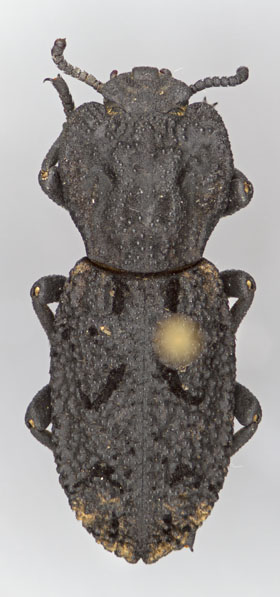 |
 Previous Genus Next Genus Previous Genus Next Genus 
Genus: Phloeodes
Diagnostic Features
- Description: Antennae 10-segmented with a 2-segmented club. Antennal setation sparse. Eyes well-developed, elongate-oval, somewhat reniform, coarsely faceted, extending well onto dorsal portion of head. Lateral margins of pronotum arcuate to sinuate, without distinct lobes. Pronotal disc with several depressions and numerous small, round tubercles. Apical margin of hypomeron variable, with weak depression to complete antennal cavity. Prosternum without distinct transverse groove. Procoxal cavities closed. Metacoxae widely separated, separation as wide or wider than metacoxal length. Scutellum greatly reduced or absent from view. Abdominal ventrite 5 with an irregular preapical groove. Tarsal formula 5-5-4. Dorsal surface granulose. Dorsal and ventral surfaces commonly encrusted with dirt and debris.
- Similar genera: The genus Phloeodes is similar to the genera Sesaspis, Phellopsis, and Zopherus. Phloeodes is most similar to Sesaspis, but can be distinguished by antennomere 3 distinctly longer than 4 (in Sesaspis, antennomere 3 only slightly longer than 4) and the pronotal disc mostly flat, bearing small, round tubercles (in Sesaspis, with more well-defined raised ridges). Phellopsis can immediately be distinguished by the 11-segmented antennae with a 3-segmented club, narrowly open procoxal cavities, hypomeron with lack of depression/antennal cavity, and a small but visible scutellum. The genus Zopherus can immediately be distinguished by the 9-segmented antennae with a 1-segmented club composed of 3 fused segments, the deep antennal cavities on the prothoracic hypomera, and the paired rows of fine golden setae on all femora and tibiae.
Known Distribution
- Southcentral (TX), Southwest (AZ, CA), Northwest (OR) USA.
Biology
- It is speculated that some members may be morphologically adapted (as larvae) for boring into sound wood (Doyen and Lawrence, 1979; Ślipiński and Lawrence, 1999).
- Abundance: moderately rare.
North American Species (2)
Discussion
- Phloeodes diabolicus: Antennal cavities of prothoracic hypomeron complete, clearly limited (enclosed) posteriorly. Elytral apical declivity with several small, round tubercles and one larger raised area. Body generally dark black, elytra often with pale velvety patches of setae at humeral angles and apex. Distribution: Arizona, Oregon, California, USA.
- Phloeodes plicatus: Antennal cavities of prothoracic hypomeron incomplete, not limited (enclosed) posteriorly. Elytral apical declivity with several large, irregular tubercles/raised areas, each elytron with three main nodules. Dorsal vestiture even throughout, generally clothed in lighter colored setae. Distribution: Arizona, California, USA.
Discussion
- Other specimens of Phloeodes have been seen bearing locality data from Alaska, Washington, Oklahoma, Pennsylvania, Texas and Wisconsin, but these records are questionable. It is doubtful natural populations occur there.
Potential Problems with Identification
- Members of this genus are frequently encrusted with dirt and other debris which may conceal the diagnostic characters.
Selected References
|
 |
 
Phloeodes diabolicus
© N.P. Lord |
© 2011-2015 Lord, N.P., Nearns, E.H., and K.B. Miller
The University of New Mexico and Center for Plant Health Science and Technology, USDA, APHIS, PPQ.
|


